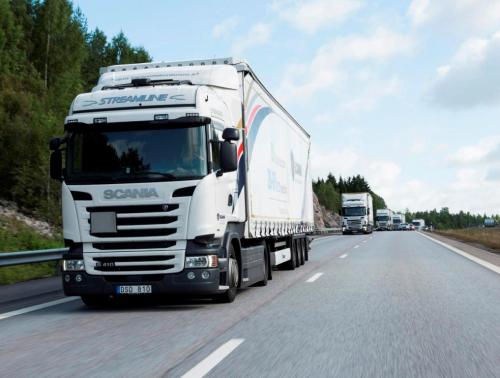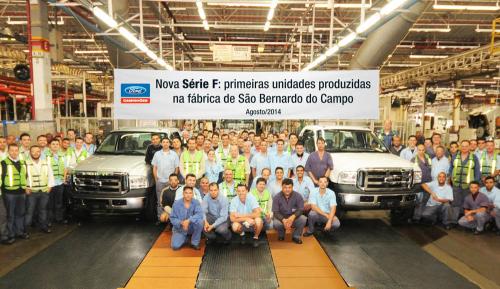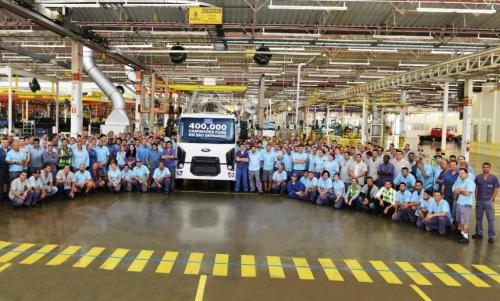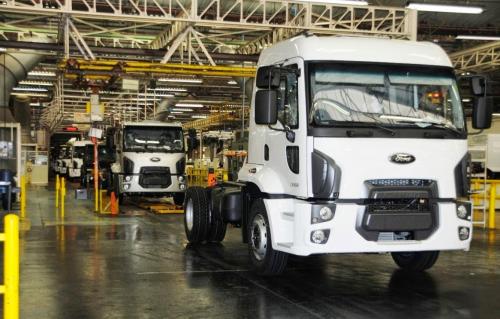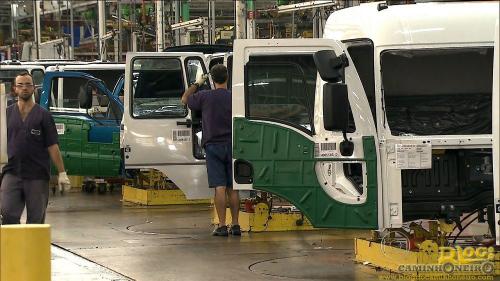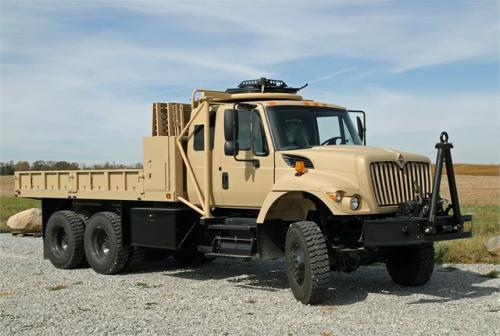
kscarbel2
Moderator-
Posts
18,868 -
Joined
-
Days Won
114
Content Type
Profiles
Forums
Gallery
Events
Blogs
BMT Wiki
Collections
Store
Everything posted by kscarbel2
-
Renault Trucks Press Release / September 10, 2015 Renault Trucks will be displaying the new additions to its range of firefighting vehicles during the 122nd French Firefighters’ National Convention, to be held in Agen from 23 to 26 September 2015. Leader on the French market for rescue and firefighting vehicles with a market share of 72.3%, Renault Trucks will be exhibiting a broad selection from its Fire and Rescue offering: vehicles from 2.8 to 32 tonne featuring outstanding maneuverability which enables firefighters to reach the site of emergency situations under all circumstances in urban and rural areas, as well as in hard to access locations. The new features Renault Trucks is offering on this range include new chassis layouts for the Fire Tenders. These free up space along the left and right side members, meeting firefighters’ needs by significantly increasing storage space for their equipment. Visitors will also be able to see the new Renault Trucks K crew cab version, a model available in XL (6 seats) and XXL (8 seats) versions. Finally, Renault Trucks will also be showing a Renault Master Public Transport with a new Euro 6 engine in a four-wheel-drive version. Five vehicles will be on display: - Renault Trucks D Cab 2,1m 4x2 Fire tender - Renault Trucks D Cab 2,1m 4x4 Forest Fire Tender - Renault Trucks D Cab 2,1m 4x4 Rural Fire Tender - Renault Trucks K 6x6 XL crew cab (6 seats) - Renault Master 4x4 Public Transport Vehicles in the Renault Trucks Fire and Rescue range of between 2.8 and 32 t. meet firefighters’ needs wherever they have to operate, whether in urban or rural contexts. The Renault Master, Renault Maxity, Renault Trucks D 2m and 2.1m cab, with their spacious interior volumes and excellent manoeuvrability, are used for rescue operations in urban environments. In its 4x4 version, the D Cab 2.1m can operate in rural or forest environments, backed up when necessary by vehicles from the C and K ranges. Their obstacle clearing capacity, high ground clearance and outstanding pulling power enable them to reach the most hard to access locations. Finally, using the Bodybuilder tool, its services and Internet portal, Renault Trucks provides an exclusive service for bodybuilders, assisting them with the complex electronic parameter setting operations these vehicles require. Photo gallery - http://corporate.renault-trucks.com/en/press-releases/nouveaux-amenagements-de-la-gamme-incendie-de-renault-trucks-au-congres-des-sapeurs-pompiers.html
-
Scania Press Release / September 10, 2015 Each day, fully loaded trucks ply the roads from Scania’s production units in Södertälje, Sweden, to its assembly plant in Zwolle in the Netherlands. In addition to engines, gearboxes and axles, the trucks are also jam-packed with information. This information is transmitted to Scania’s R&D engineers as the basis for innovation and product improvements. “Our aim is to continuously strive for even more efficient vehicles,” says Anders Gustavsson, who heads the Scania Transport Laboratory. The operation could be characterised as a laboratory on wheels to evaluate performance in actual transport conditions. With 40 trucks in operation, including those used for internal transport between production units in Södertälje, loads of information is generated. In order to ensure that data is not exclusively related to the driving patterns of individuals, drivers regularly switch trucks with each other. Uptime is paramount at Scania Transport Laboratory and the trucks are regularly maintained and serviced according to stipulated intervals. “We expect 20 workshop hours for trucks that operate an average of 400,000 kilometres annually,” Gustavsson reports. “That corresponds to an uptime ratio of 98.7 percent.” The information gathered en route finds its way to Scania’s development engineers for careful analyses. Results are subsequently utilised to even further enhance efficiency, enabling customers to maximise their investments in vehicles. “One example is the extended interval between two oil changes. Previously, oil was changed after 40,000 kilometres while we now find it sufficient to change oil after 110,000 kilometres. Another example is adjusted gearchanging that can lower RPMs, which are commonly 1,200–1,300 RPM at 80 km/h, to 1,000 and thereby reduce fuel consumption.” Anders Gustavsson is constantly in search of new ways of improving efficiency. And the driver is, of course, at the centre. “We have a continuous programme to coach each driver on the basis of the information collected.” .
-
Daimler Trucks North America (DTNA) / September 10, 2015
-
Reuters / September 10, 2015 Workers at a Ford Motor Company plant in Brazil began an open-ended strike on Thursday to protest job cuts, adding to labor tensions that have rattled the country's auto industry in the midst of its worst crisis in nearly two decades. The local metalworkers union said about 4,300 employees at Ford's Sao Bernardo do Campo plant, which makes F-Series and Cargo commercial trucks, went on strike after the company sent pink slips to some 200 workers. A Ford representative said the automaker had to reduce its workforce at the factory due to excess capacity in the face of slumping demand, but the company did not confirm the extent of the layoffs. So far this year, heavy truck sales are down nearly 45 percent due to tighter credit, relentless inflation and a sharp economic recession. General Motors Co and Daimler announced plans to cut 800 and 1,500 jobs from their respective Brazilian plants last month before backing off in the face of stiff union resistance. .
-
Here's Why XPO Wants to Buy Con-Way Bloomberg / September 11, 2015 http://www.bloomberg.com/news/videos/2015-09-10/here-s-why-xpo-wants-to-buy-trucker-con-way
-
Toddler dismembered, thrown into park pond Associated Press / September 10, 2015 Chicago police have released a sketch of a toddler whose dismembered remains were found in a park lagoon and appealed for public's help in identifying the child. The black-and-white drawing shows an African American or bi-racial child between the ages of two and three with large wide eyes and a chubby face. 'We still don't know what happened,' Police Superintendent Garry McCarthy told reporters during a Thursday afternoon press conference, 'We're going to need help from the public. And people should be outraged.' The child's remains were discovered over the weekend in the Garfield Park lagoon after someone reported seeing a foot floating in the water. Further searches of the murky water turned up the child's head, hands and other foot. Authorities are draining the lagoon using water pumps to aid the search for the rest of the body and more evidence. 'I don’t have the words strong enough to describe how reprehensible this incident is,' Chicago Police spokesperson Anthony Guglielmi said. 'The fact that somebody could do this to a child is frankly unimaginable. 'There’s somebody out there that knows what happened to this child. Do the right thing, turn yourselves in. We are going to find you.' More than 100 divers and law enforcement officials are helping with the case, which has been described by Chicago PD's top brass as a '24/7' investigation. Forensic sketch artist Timothy McPhillips of the Cook County Sheriff's Office said he made the drawing after examining X-rays, coroner photographs and the remains themselves. There are no piercings, so the child could have been male, but authorities aren't sure because the torso has not been recovered, McCarthy said. There are no reports of any missing children in Chicago that match the case, he added. The child's DNA is being analyzed to see if there's a familial match with anyone whose DNA is stored various law enforcement databases. Also unclear is whether the child was murdered, because the dismemberment occurred after the death, according to the medical examiner. McCarthy said detectives would not stop until they solved what he called a 'heinous, senseless crime.' The search began at around 4.40pm Saturday after someone reported seeing what turned out to be a left foot floating in the lagoon. Officers later found a decomposed right foot and a hand about 25 yards away. Police said Sunday night that officers had recovered additional body parts, including a head and another hand, from the park and categorized the case as a death investigation. Investigators estimated the remains had been submerged in the lagoon for a week or two. Police also recovered a 20-pound weight and several plastic bags near the remains, but they have not said whether those items had been used to dump the child’s body parts. .
-
Automotive News / September 10, 2015 Fiat Chrysler Automobiles (FCA) said it is recalling about 1.73 million trucks for defects including a wiring harness that may short-circuit and set off an airbag. The largest recall covers 1.06 million trucks in the U.S. An investigation by the company has discovered that certain trucks may have steering-wheel wiring harnesses that wear because of contact with a spring, FCA said in a statement today. Such wear may cause a short-circuit that may lead to inadvertent driver-side airbag deployment. The company said it was aware of two injuries due to wiring harnesses wear, but no accidents. FCA also said an additional 156,498 heavy-duty trucks were being recalled as they were supplied with steering components that may have welds with insufficient fusion. This may cause separation and lead to diminished steering response. The company said it was aware of a single minor accident in the United States related to the condition of bracket welds, but was unaware of any injuries. As well, about 188,000 vehicles are being recalled to make their side-curtain airbags compliant with a federal regulation to reduce the risk of rear occupant ejection during a rollover. The company said it is also recalling 323,183 trucks in Canada, Mexico and outside North America to fix wiring harnesses and bracket welds. In July, Fiat Chrysler agreed to pay a record $105 million penalty and take steps following a government investigation of the company’s handling of 23 recalls involving more than 11 million cars and trucks. The National Highway Traffic Safety Administration demanded that consumers be able to sell their vehicles back to the company if repairs haven’t been completed. As part of the July agreement with the government, Fiat Chrysler agreed to hire an independent monitor to ensure it will no longer delay safety recalls.
-
House bill would increase Interstate weight limit to 91,000 pounds
kscarbel2 replied to kscarbel2's topic in Trucking News
Congress can give US economy the truck it needs By Rep. Reid Ribble (R-Wis.) - 09/10/15 U.S. manufacturers are struggling with a major supply chain capacity crisis – one that is threatening not only the movement of goods, but our nation’s economic productivity. While the U.S. is producing and shipping more goods to meet the resurgence in consumer demand, this record freight volume—combined with increasing railroad bottlenecks, tight highway lane capacity and escalating truck driver shortages—has created a perfect storm. Companies are not only struggling with the price tag associated with getting goods to market; they are often hard-pressed to get them there at all. Even though rail is often the first shipping choice for American manufacturers, the reality is that more than 70 percent of freight must, at some point, be shipped via truck, and that tonnage will only increase as demand grows. In fact, industry experts estimate that overall freight tonnage will increase nearly 25 percent over the next decade alone. Our transportation network is in no shape to keep up with this growth. The U.S. population has nearly doubled since the Interstate highway system was built, and over the last 30 years, truck miles traveled have increased 20 times faster than road capacity—often with limited-to-no room for expansion. Fortunately, Congress has the power this fall to give our Interstate productivity a critical, yet safe, boost. Safer, more efficient trucks that can carry 91 thousand pounds as opposed to the current 80 thousand on our highways exist, and our major trading partners already use them successfully. In Canada and Europe, many trucks are already carrying over 100 thousand pounds safely on the road. These trucks, which are the same size as typical 18-wheelers but equipped with six axles rather than five, can safely ship more goods while braking faster, handling the same, polluting less and reducing pavement wear—all this according to the U.S. DOT’s recently completed Comprehensive Truck Size and Weight Study. Congress just needs to give states the power to put these better trucks to work. The Safe, Flexible and Efficient Trucking Act, known as the “Safe Trucking Act,” now pending in the House, would answer the call by giving each state the option to allow more productive, yet safe, six-axle trucks to travel on Interstate highways. The Safe Trucking Act would responsibly alleviate the capacity crisis and create a more efficient transportation network in which U.S. manufacturers can safely use fewer truckloads, fuel and emissions to meet demand. The legislation also enables the U.S. DOT to require additional safety equipment for these trucks, creating a world-class standard for truck shipment. The U.S. DOT has already confirmed that the Safe Trucking Act configuration complies with existing bridge weight requirements and would not cause additional strain. Still, implementation of the Safe Trucking Act is completely voluntary. Each state would retain the ability to control when and where these trucks travel. Yet given that more than 90 percent of states already allow heavier, five-axle rigs on state and local roads, the Safe Trucking Act also presents a critical opportunity for states to transition to safer, more capable six-axle trucks which can operate on Interstate highways—the safest place for truck shipments. Five years ago, Congress granted Maine the ability to do what the Safe Trucking Act would do on a national scale: give higher weight vehicles access to the state’s Interstate highways. Since then, fatalities on Maine’s roads have reached their lowest levels in 70 years—a reduction which officials have attributed to this truck weight change. It’s time for U.S. truck productivity to match that of the United Kingdom, Canada and other countries that already utilize these trucks, and with the Safe Trucking Act, we can do so in a way that empowers and respects state autonomy while making our shared roads safer. Our transportation network is facing big challenges, and the Safe Trucking Act represents an essential part of the solution. Ribble has represented Wisconsin’s 8th Congressional District since 2011. He sits on the Foreign Affairs and the Transportation committees. -
Owner/Driver / September 11, 2015 There’s nowhere to hide for Burdett’s 2013 Mack Super-Liner. It would be an understatement to say that the Mack Super-Liner Mick Eastwood drives for P&A Burdett Haulage stands out from the crowd. Firstly, the prime mover is dark blue, as compared to the rest of the Langwarrin, Victoria-based company’s fleet. Then there’s the high sided B-double tippers with Burdett’s graphics setting the entire combination off, making it an extremely eye-catching rig. "Yes, mine is the only blue one, and it’s a great looking truck," Mick says. "Andrew Burdett has bought quite a few Macks recently and there was a deal at Mack that fell through, so Andrew jumped on it. "It stands out from every other truck in the yard." More to the point, driving the Super-Liner means it’s hard to be inconspicuous. "You’ve got the company phone number written all over the side of the truck, and you can’t miss the name." Although he’s more Kenworth inclined, Mick doesn’t mind the truck at all. But he is not that keen on the Mack’s mDrive automated manual transmission (AMT). "Having grown up loving trucks and driving them properly and now not having to change gears is quite a challenge and takes some getting used to," he says. "Also, having a Kenworth tattoo on my leg doesn’t help, but it’s a great job that I’ve got and it pays well." The Super-Liner is rated at 685hp (511kW) but Mick has been told it is now up around 720hp (537kW). "Overall it is a very comfortable and easy-to-drive truck; very roomy and it rides well." While Burdett Haulage’s primary work is in and around Melbourne, Mick spends most days out in the country, regularly going up into New South Wales and occasionally across to South Australia. He enjoys the variety the job offers. "Burdett’s have opened up a lot now, especially what areas we travel to," he says. The company specialises in garden, nursery and landscaping supplies, bringing products out of Geelong and up to Condobolin and surrounding areas. "I’m only away from home a couple of nights a week so the home life still stays pretty good but at the same time, I still get out into the country and camp at a few pubs that permit it," he says. "I really enjoy the mix that the job offers." Photo gallery - http://www.ownerdriver.com.au/industry-news/1509/mack-super-liner-a-billboard-on-wheels-for-burdett-haulage/
-
Heavy Duty Trucking / September 10, 2015 The U.S. Army Contracting Command has awarded Navistar Defense a $369 million contract to provide 2,293 Medium Tactical Vehicles (MTVs) to add to the Afghanistan National Security Force's fleet. Production will commence immediately, with deliveries starting in January 2016 and concluding in 2019. Under the contract, Navistar Defense will provide troop, cargo and ammunition transports, water and fuel tankers, and wreckers. Some will have armored cabs to protect occupants against roadside bombs. The 6x6 trucks are based on the International WorkStar 7400-MV severe-service vocational chassis, the company said. They will have MaxxForce 8.7L diesels and 6-speed manual transmissions. "We are honored to continue supporting the efforts of the Afghanistan National Security Force's missions to provide security and rebuilding in their country," said Kevin Thomas, president, Navistar Defense. "We have been supporting ANSF since 2005 and have provided more than 9,000 medium-duty vehicles to the Afghan forces during that time." Workers at Navistar's plants in Springfield, Ohio, and West Point, Miss., will assemble the trucks. .
-
Fleet Owner / September 10, 2015 In a move with big ramifications for the North American freight market, XPO Logistics said this week it plans to purchase trucking and logistics conglomerate Con-way Inc. lock, stock, and barrel for roughly $3 billion, rebranding all of Con-way’s operating companies – LTL carrier Con-way Freight, Menlo Logistics, Con-way Truckload and Con-way Multimodal – under the XPO moniker. Under the terms of the agreement, XPO said it will launch a tender stock offer for all of Con-way's outstanding shares at a cash price of $47.60 per share. Following the tender offer, if successful, Con-way will become a wholly owned subsidiary of XPO. Bradley Jacobs, XPO’s chairman and chief executive of XPO Logistics, will lead the combined company with Douglas Stotlar, Con-way's president and CEO, serving in a “limited role” as an independent advisor to the combined company through the first quarter of 2016. "Our opportunistic acquisition of Con-way will make XPO the second largest provider of LTL transportation in North America, [which is] a $35 billion market,” Jacobs said in a statement. “LTL is a non-commoditized, high-value-add business that's used by nearly all of our customers. Con-way is a premier platform that we will run with a fresh set of eyes as part of our broader offering.” More importantly, he added, XPO gains strategic ownership of assets that will benefit both itself and customers during periods of “tight capacity.” Jacobs also noted that the Con-way acquisition will nearly double XPO’s pro-forma full year earnings to approximately $1.1 billion and increase our revenue to $15 billion upon its closing. “We'll immediately begin executing our plan to improve the operating profit of the acquired operations by $170 million to $210 million over the next two years,” he said. Con-way’s Stotlar pointed out in a statement that the “combination” of XPO and Con-way “will mean more services for our customers, more miles for our drivers, and more career opportunities for our employees as part of XPO's global organization.” XPO’s Jacobs highlighted several other key aspects of this deal for both companies from an operational and costs saving perspective: The combination will strengthen XPO's position in the highly desirable e-commerce sector, which is projected to grow at a pace of 18% to 21% annually. XPO and Con-way both have e-fulfillment contract logistics platforms in North America and Europe.Between the recent acquisition of Norbert Dentressangle, and the planned acquisition of Con-way, XPO will have significantly more ground transportation capacity to serve customers in Europe and North America. XPO's network of brokered, owned and contracted capacity will have lane density covering approximately 99% of all postal codes in the United States, as well as the regions that produce 90% of the Eurozone's GDP. The addition of Con-way's truckload fleet, including dedicated carriage, will increase cross-border Mexico services, which include intermodal, truck brokerage and expedite. Cross-border growth is projected to outperform industry growth, due to the near-shoring of manufacturing.The combination will grow XPO's global ground transportation network to approximately 19,000 owned tractors and 46,000 owned trailers, 10,000 trucks contracted through independent owner operators, and access to more than 50,000 independent carriers. In North America, XPO will have approximately 11,000 owned tractors and 33,000 owned trailers, 6,000 trucks contracted through independent owner operators, and access to more than 38,000 independent carriers.Within a year, XPO expects to leverage its combined technology infrastructure to reduce Con-way's annual technology spend of $227 million, which is largely outsourced;Expand XPO’s freight brokerage platform with the integration of Con-way's $200 million brokerage business, to share capacity and data through XPO's proprietary Freight Optimizer technology.By year two of the acquisition, XPO expects to reduce its $3.6 billion combined spend on purchased transportation;Using the larger flow of data from its combined $2.7 billion of freight under management to identify carriers, assign loads and fill backhauls more efficiently.
-
Fleet Owner / September 10, 2015 One hundred years to the day that the company was entered into the trade register, ZF Friedrichshafen AG celebrated its anniversary. On Wednesday evening, around 1, 500 international guests from the automotive industry, business, government, and the community as well as friends and business partners of the company traveled to Lake Constance to attend the gala event at the trade show grounds in Friedrichshafen, the company said. According to the company, on Sept. 9, 1915, “Zahnradfabrik GmbH,” headquartered in Friedrichshafen, Germany, was entered into the trade register of the Tettnang district court. The aim of the newly founded company was to produce gears and transmissions for aircraft, motor vehicles, and motorboats. It was not long before ZF began offering its technology to automobile manufacturers. “Even 100 years after its founding, ZF is still driven by its desire to invent new technologies and perfect existing ones,” said CEO Stefan Sommer in his speech during the event. “Reliability and innovation represent the general values of our company and are the basis of our actions.” Sommer emphasized that in light of increasing digitalization and networking in automobiles, it is not enough to simply collect components. “Intelligently combining mechanics, electronics, and big data is decisive in developing adequate solutions for the mobility trends of the 21st century,” he said. “ZF is now very well positioned, as a system supplier, to be a global partner for automobile and commercial vehicle manufacturers. It has the capacity to be a one-stop shop for supplying the right products and technologies.” The trend toward autonomous driving and electromobility will change automobile use and technology more than any other previous developments, the company said. “Nevertheless, it will probably still take more than two decades before electromobility achieves a dominating market share,” Sommer said. “Even if we devote all of our effort to developing the electric drive, ZF will also have to look closely at driveline hybridization in order to increase the efficiency of cars and further reduce emissions.” Matthias Wissmann, president of the German Association of the Automotive Industry (VDA), underlined in his speech the importance of the German automotive industry for the German economy. “Cooperation between manufacturers and suppliers is the core reason for the leading technology position that the German automobile industry has established for itself,” he said. “Our joint goal must be to link innovative value-added structures so that we grow exactly where our markets are growing – and, at the same time, keep Germany as a manufacturing location strong. Because this is where our roots run deep and this is where they will stay. Here, too, is where we intend to shape the future of mobility. To do so, we need a forward-looking framework. Because one thing is clear: competitiveness is neither a static condition nor is it self-sustaining. Legislators must do a better job of addressing the many issues of competitiveness. At present, it will probably not be easy to find political majorities on these issues, but it is absolutely critical.”
-
Fleet Owner / September 10, 2015 As PC-11 draws closer, Shell Rotella continues to refresh WhatIsPC-11.com with updated information about the upcoming diesel engine oils specification. New information includes details about how the specification is being developed including testing, the two oils that will be used for current and older engines and for new 2017 engines, and the changes you can expect for the new engine oils. A new section, called “The Future of Fuel Economy,” has been added which shows how fuel economy in Class 8 trucks has increased only slightly over the past 35 years. With an industry-wide effort to increase fuel economy, Shell Rotella and the AirFlow Truck have teamed up to break existing fuel-mileage records through the StarShip Initiative. The page will chronicle the development of the StarShip truck, which will use new PC-11 engine oils and other fuel efficient lubricants made by Shell. “WhatIsPC-11.com is an industry resource for topics related to PC-11, including what it means for fleets, owner/operators, off-highway vehicles and diesel-powered pickup truck,” Shell Rotella said. “PC-11 engine oils are expected to affect new, current and older engines when the category replaces API CJ-4 engine oils.” The new API category is being driven by changes in engine technology to meet emissions, renewable fuel and fuel economy standards for reduced CO2 and other greenhouse gas emissions. In addition, the new specification refreshes test limits in response to changes in engine hardware and operating condition The last heavy-duty engine oil category, CJ-4, was introduced in 2006. Several engine tests need upgrading and older test hardware is expected to become unavailable. When PC-11 is licensed, Dec. 1, 2016, it will have been almost 10 years since the current category was introduced.
-
Fontaine Fifth Wheels in Fatal Accident Recalled
kscarbel2 replied to kscarbel2's topic in Trucking News
Jost is the first name in fifth wheels. -
Heavy Duty Trucking / September 10, 2015 An accident in early 2014 has led to a recall of a fifth wheel model that allowed a semitrailer to decouple and hit two pickup trucks on an Ohio highway, killing their drivers. Fontaine Fifth Wheel Co. said an Ohio Highway Patrol investigation found that the Ultra LT unit was not defective, but has agreed to recall about 6,800 of them and replace them at no charge to tractor owners. Fontaine will also pay for up to $100 for labor involved in a switch to a newer model, the Ultra NT, which includes a No-Slack, two-lock design. The recalled LT fifth wheels carry part number SLTPL4000, and were manufactured from July 29, 2009 to May 27, 2013, according to an announcement by the National Highway Traffic Safety Administration. Fontaine sold them to Daimler, Volvo, Mack, Navistar and Paccar for installation on their truck-tractors. The crash occurred about 6:30 a.m. on January 24, 2014, on a hilly, curving section of U.S. 50 east of Cincinnati, news reports said. The trailer, loaded with groceries, dropped off the tractor and slid into oncoming traffic, striking the pickups. Their drivers, Michael Brown, 43, and Shawn Wilson, 39, were killed. Police said Michael Simpson, 62, the truck's driver, failed to properly inspect the fifth wheel’s locking mechanism and did not see that its jaws had not fully grasped the trailer’s kingpin. They said that frozen grease and lack of maintenance had prevented the jaws from locking. Prosecutors charged Simpson with vehicular manslaughter, and he was convicted this past June. His commercial driver's license was suspended for 90 days and he got a year's probation. Civil suits against him, his company and other parties may yet be filed. “Over time, improper coupling techniques may result in cumulative damage to the fifth wheel and its locking mechanism, which in turn may result in the locking mechanism failing to operate or to properly engage,” NHTSA’s recall announcement said. “If the fifth wheel and locking mechanism are sufficiently damaged, the locking mechanism may fail to operate as intended and the trailer may unexpectedly detach from the tractor, increasing the risk of a crash.” Fontaine Fifth Wheel’s president, Ken Kelley, said the Ultra LT had been discontinued in 2013 as part of a “product rationalization” to reduce the number of products and parts. While the LT was in production, Fontaine made lock-related improvements and issued a technical service bulletin warning of possible problems if the fifth wheels were improperly used and not properly maintained, a company statement said. Following the accident, “Fontaine proactively reached out to NHTSA in May 2015 to discuss conducting a field campaign to replace the remainder of the subject population of the 2009-2013 Fontaine Ultra LT fifth wheels sold in the United States in response to continued field observation of damaged fifth wheels,” the statement said. “Fontaine did not consider there to be a safety related defect in the units, but had decided to replace the units to provide more robust feedback to operators, to reduce the potential for operator error and to eliminate the need to continue to stock parts and repair kits for a discontinued product.“ Related reading - http://www.bigmacktrucks.com/index.php?/topic/40787-fontaine-ultra-lt-5th-wheels-being-investigated/?hl=fontaine
-
Commercial Carrier Journal (CCJ) / September 10, 2015 U.S. Rep. Reid Ribble (R-Wisc.) introduced Thursday the latest version of his Safe, Flexible and Efficient Trucking Act (Safe Trucking Act), which would give states the flexibility to allow 91,000-pound (41.28 metric ton) trucks with six axles on U.S. Interstate highways within their borders. Ribble, at a press conference on Thursday, said increasing the weight limit to 91,000 pounds with six axles would increase the industry’s productivity by increasing capacity. It would also reduce congestion and boost safety, he said. “Having the sixth axle is critical to weight displacement and braking power,” Ribble said. “The interstates are the safest and most efficient places for trucks to move.” He added that, according to the U.S. Department of Transportation’s recent Truck Size and Weight Study, a 91,000-pound configuration would be suitable for the current Interstate system, resulting in no additional rehabilitation costs for the roads or bridges. ohn Runyan, executive director of the Coalition for Transportation Productivity, said most states already allow trucks that weigh more than 80,000 pounds to travel on state and county roads. “It’s also important to recognize that more than 90 percent of states allow trucks which are heavier than the federal weight limit to travel on state roads, often on just five axles,” Runyan said. “The Safe Trucking Act gives these states a critical opportunity to promote the use of safer, six-axle vehicles while transitioning heavier traffic to more capable Interstate highways for at least a portion of their route. Paired with the U.S. DOT’s ability to require even more safety technology, the Safe Trucking Act is an opportunity for our nation to create a world-class standard vehicle for the movement of heavy goods.” The American Trucking Associations generally supports increasing size and weight limits, while the Owner-Operator Independent Drivers Association generally does not. Ribble said that by 2025, tonnage moved by trucks is expected to increase by 25 percent, and the bill would help reduce the number of trucks on the road as the amount of freight being moved increases, he said. James Sembrot, senior director of transportation for Anheuser-Busch InBev, said the trucks they load leave the facilities only half full because they meet the 80,000-pound (36.29 metric ton) weight limit well before they fill the trailers. “By allowing us to increase the weight and by adding the sixth axle, Anheuser Busch would reduce its number of loads by 14 percent,” Sembrot said. “This would take 100,000 trucks off the highways over the course of a year. Removing trucks also helps us reach our goal of lowering greenhouse gas emissions by 15 percent in 2017.” Ribble said the act will be introduced in the House as an amendment to a proposed highway bill in an effort to keep the base bill clean. He said he’s had conversations with Rep. Bill Shuster (R-Pa.), the chairman of the Transportation and Infrastructure Committee, and feels Shuster won’t oppose the legislation. “The Chairman has always wanted broad, bipartisan support, and he’d rather keep the base bill clean and let the members of the committee decide,” Ribble said. The cost to retrofit a traditional trailer to add an extra axle would be approximately $7,400 for each trailer, according to Sembrot, who said he’s looking into it for Anheuser Busch’s trailers. Runyan said many shippers he spoke with said the change to add another axle to the trailer would likely come when they turn over their equipment. “This will be a gradual change that takes some time,” he said.
-
CAT Trucks Shine in Western Australia’s Southwest
kscarbel2 replied to kscarbel2's topic in Trucking News
Yes, the Aussie CAT long haul trucks are based on the ProStar platform. But to meet the VERY demanding conditions of Oz, they are engineering quite differently. No tales. Come down to Oz for a look. It's good for the mind to get out of town.....out of your normal life "box".......you'll be telling everyone for months that the trip was one of the best decisions you ever made. Ask Tim. As a bonus, as your summer is ending, their summer is beginning -
Ryder Project Rebirth: The Story of one Truck's Death & Redemption
kscarbel2 replied to kscarbel2's topic in Trucking News
Why set your sights so low? A Volvo? We're going to create some truck bumper decals for the US market Volvos but are still debating the language. Some current ideas are: I know, I know.....but my other truck's a Scania In my next life, I hope to come back as a Scania When I grow up, I'm going to be a Scania I should have bought a V-8 (Scania) -
"People should and do trust me" - Hillary Clinton
kscarbel2 replied to kscarbel2's topic in Odds and Ends
What is so sad here is........most Americans have little to no interest in this matter (and so many important others). But then again, at the end of the day (actually right at the beginning), they are powerless to do anything about it. The aristocracy will duke it out and decide Hillary's fate, the masses can only glean a few details and watch the show. -
Toledo Mother Murders 6-Month-Old Baby NBC24 / August 13, 2015 Toledo mother Ariana Cannon has been charged with murder in connection to the death of her six-month-old son. The judge set her bond at $1 million. Officers from the Toledo Police Department responded to Toledo Hospital on a report of an injured child on Sunday, Aug. 9. The infant, Carsyn Cannon, succumbed to his injuries on Tuesday, Aug. 11. After police investigated the incident, a search warrant was executed and the infant's mother, Ariana Cannon, 20, was taken into custody on Wednesday. She has been charged with aggravated murder after investigators consulted with the Lucas County Prosecutor's Office and the Lucas County Coroner's Office. Investigators say Carsyn died from a fractured skull. The baby also had a fractured leg. The injuries were not believed to be caused by an accident. Cannon is expected to be arraigned Thursday morning in Toledo Municipal Court. .
-
Arizona Mother Drowns Baby Daily News / September 9, 2015 A Phoenix mother allowed her 1-year-old baby to drown and blamed the death on her 3-year-old toddler daughter. Brenda Ramirez, 21, was arrested on child abuse charges for the death of her baby Melani and charged with two counts of felony child abuse. After discovering the baby in the bathtub, the mother reportedly sent a text message to a friend which read, “Dude i think [toddler daughter] drowned Melani.” Ramirez followed up with a second text which said, “Shes not breathing,” followed by four crying emoticons. The friend then thought to call 911 to try and get help for the baby. Ramirez reportedly deleted the texts from her phone and could not explain to the police why she had done so. During questioning, the police report indicates that the mother of the drowning victim said, “This sucks, but oh well, you have to move on.” When asked what she meant, Ramirez reportedly said that she was not referring to her dead baby but was talking about money. Exactly what “money” she was referencing remains unclear. Brenda Ramirez initially blamed the death on her 3-year-old daughter, stating that the toddler must have pushed the baby under water. She first told police that the bathtub only had three inches of water in it when she walked away. When she returned about two minutes later, the tub had significantly more water in it. She claimed that she left the baby and the toddler alone to get some pajamas and then she came back. It was this point she saw her older daughter holding Melani under the water. First responders attempted CPR, but Melani was declared dead at a local hospital shortly after she was placed in the ambulance. The toddler girl has been removed from the home and placed in the custody of the state. When investigators asked why her clothing was not wet from getting the children out of the tub or trying to rescue the baby, Ramirez did not have an answer. Arizona police stated that Brenda Ramirez “changed her story” multiple times after the death of Melani. The law enforcement officials also noted that the mother said she “felt guilty” about what had happened. A representative from the Maricopa County Sheriff’s Office said that Ramirez had been granted bond and released from jail on Tuesday. Ramirez also claimed that the drowning death of the baby would not have happened if Miguel Contreras had not been arrested several hours earlier. The Arizona father had been spotted standing on a ladder attempting to get into an apartment bedroom window while holding two guns, ABC 15 Arizona reports. The couple had gotten into a physical altercation, and Ramirez reportedly locked the father of her children out of the home. He was arrested and booked on disorderly conduct charges. .
-
Missouri Infant Murdered KCTV5 / September 1, 2015 ST. JOSEPH, MO - A St. Joseph man and a mother have been charged in connection with Thursday's death of an 12-month-old infant inside a drug house. The boy's mother, 28-year-old Sasha Joann Lizar is charged with first-degree endangering the welfare of a child. Roy Kenneth Miller Jr., 59, is charged with felony abuse of a child resulting in death. Neighbors didn't even know the child was staying in the boarded up mobile home near South 36th and Monterey streets until they heard screams for help last Monday and tried to save the baby. John Miller, who is not related to the suspect, said he was doing yard work when he heard Lizar's screams for help. "She was screaming for help. She was holding something and I looked over and she kind of turned to me and she's holding that little boy," John Miller said. "The mom was hysterical. I've never seen her or her son before." Miller says his military training kicked in and he began CPR. "His heart would race and then stop so I'd do a chest compression," Miller recalled. "He wasn't breathing. Every so often he'd gasp for air." Court records state that Miller assaulted the baby by violently shaking him, causing substantial brain trauma resulting in his death. Police said Miller had care custody and control of the child at the time of the injury. Police said Lizar would bring her baby to the trailer to use methamphetamine and others there were also using drugs around the child. .
-
Man murders 7-month old infant WBNS / September 2, 2015 A man is in jail in connection with the death of a baby and neighbors say it's something they feared would happen. The Ross County Prosecutor charged 37-year-old Daniel Gilbert following the death of a 7-month-old baby at a home in Waverly last Sunday. Gilbert is the mother’s boyfriend. Neighbors say they’ve called authorities before, worried for the safety of the six children who lived in the home. Ross County Sheriff’s deputies went to their home on August 30th for a report on an unresponsive infant. Authorities determined the small child died from blunt force trauma to the back of the head. Deputies arrested Gilbert and charged him with child endangerment, saying he knew about the injuries and did nothing. He is being held at the Ross County Jail under a $50,000 bond. Three other children living in the home were removed as a precaution. Children’s services and local law enforcement have been called to the home before. Neighbors say they’ve seen toddlers out in the middle of the road and trucks would have to stop. The Ross County Prosecutor said 3 children have since been removed from the home. A judge set Gilbert’s bond at $50,000. He is expected to be back in court on Friday. .
-
Pontiac woman, 18, charged in baby’s ’14 scalding death The Detroit News / August 14, 2015 An 18-year-old Pontiac, Michigan woman was charged Friday with intentionally scalding her infant cousin, just over a year after the baby died of severe burns. Breeze Macha Henke was babysitting for 12-month-old Samaria Chambers on July 26, 2014, in a home in the 200 block of South Sanford when Oakland County sheriff’s investigators say she held the baby down in a tub of scalding water because she was angry the child’s diaper was soiled. Henke initially told investigators she started to draw a bath for the child when she was distracted and a 3-year child entered the bathroom and turned up the hot water, according to investigators. Samaria suffered second-degree burns on the lower half of her body and died of the burns and multiple infections on Aug. 9, 2014, at DMC Detroit Children’s Hospital. The Wayne County Medical Examiner ruled the baby’s death a homicide on Sept. 15, 2014. A burn expert at Detroit Children’s Hospital said the baby’s burns were consistent with her being held down in the tub. Henke was arrested Thursday in Pontiac by the Oakland County Sheriff’s Office Fugitive Apprehension Team. Detectives determined from testing that the bath water reached a temperature of 158 degrees within 10 seconds, and held that temperature for almost one minute. The baby was burned from the stomach down. Asked why it took a year to bring charges against Henke, Oakland County Sheriff Michael Bouchard said the case crossed jurisdictional lines because the baby died in Wayne County, and was complicated by the lack of an adult witness other than the suspect. As a result, detectives had to rely on forensics to determine burns suffered by the child occurred deliberately or by accident. “It’s a sad reminder that some people don’t have the patience, or I guess the love, to interact with children, especially children of this age,” Bouchard said Friday. “It’s incredible sad and tragic.” Henke was arraigned Friday on charges of homicide/manslaughter, a 15-year felony, and second-degree child abuse, a 10-year felony. Judge Cynthia Walker of 50th District Court set Henke’s bond at $250,000. Henke, who is being held in the Oakland County Jail, is scheduled to appear at 1:30 p.m. Aug. 25 in 50th District Court. .
-
Infant Dies After Being Left In Hot Car News 9 / September 31, 2015 Del City, Oklahoma, police are investigating the death of an infant after the baby was left in a hot car. The case is considered a homicide. “When the officers arrived, they found the mother standing in the street with the child,” Del City police Maj. Jody Suit said. It happened about 3 p.m. Saturday outside a home in the 4600 block of SE 19 Street. The baby was already dead when help arrived. Police are not sure yet how long the baby was left in the car, but they believe the mother was in charge of the child at the time. The mother's friends identified the baby girl as Ashanti.
BigMackTrucks.com
BigMackTrucks.com is a support forum for antique, classic and modern Mack Trucks! The forum is owned and maintained by Watt's Truck Center, Inc. an independent, full service Mack dealer. The forums are not affiliated with Mack Trucks, Inc.
Our Vendors and Advertisers
Thank you for your support!


